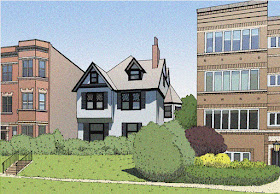Morse Avenue dead-ends at the lakefront, and, as you approach the lake, you find a wide variety of building types. These three buildings, all built between 1907 and 1917, illustrate the rapid change in density that occurred along Morse Avenue.
 According to the Assessor, the frame building in the center was built in 1907. The
building to its left followed in 1912, and the one on its right in
1917. Chicago's 1924 Zoning Code anticipated greater
density along the city's lakefront, a development that was already happening by the time the Code was adopted. In the early 20th century, just like today, there was a strong desire to be close to Lake Michigan, even if you were sharing your lakefront real estate with several other families.
According to the Assessor, the frame building in the center was built in 1907. The
building to its left followed in 1912, and the one on its right in
1917. Chicago's 1924 Zoning Code anticipated greater
density along the city's lakefront, a development that was already happening by the time the Code was adopted. In the early 20th century, just like today, there was a strong desire to be close to Lake Michigan, even if you were sharing your lakefront real estate with several other families.
All of the frame houses on this block originally had generous porches to capture cool breezes from the lake. The one above lost its porch and wood siding some time after 1937. It's looked a little bit blank ever since, but it makes up for it with an amazing roofline! The six-flat on the left side of our frame house has classical details, with limestone lintels and a pressed metal cornice with dentils. The one to its right has a sort of Craftsman appearance with very restrained ornamentation.
One final note: You'll notice that there's a hill in front of these buildings. It's a good bet these were built atop a low sand dune.
 |
| Looking North |
 According to the Assessor, the frame building in the center was built in 1907. The
building to its left followed in 1912, and the one on its right in
1917. Chicago's 1924 Zoning Code anticipated greater
density along the city's lakefront, a development that was already happening by the time the Code was adopted. In the early 20th century, just like today, there was a strong desire to be close to Lake Michigan, even if you were sharing your lakefront real estate with several other families.
According to the Assessor, the frame building in the center was built in 1907. The
building to its left followed in 1912, and the one on its right in
1917. Chicago's 1924 Zoning Code anticipated greater
density along the city's lakefront, a development that was already happening by the time the Code was adopted. In the early 20th century, just like today, there was a strong desire to be close to Lake Michigan, even if you were sharing your lakefront real estate with several other families. All of the frame houses on this block originally had generous porches to capture cool breezes from the lake. The one above lost its porch and wood siding some time after 1937. It's looked a little bit blank ever since, but it makes up for it with an amazing roofline! The six-flat on the left side of our frame house has classical details, with limestone lintels and a pressed metal cornice with dentils. The one to its right has a sort of Craftsman appearance with very restrained ornamentation.
One final note: You'll notice that there's a hill in front of these buildings. It's a good bet these were built atop a low sand dune.

No comments:
Post a Comment